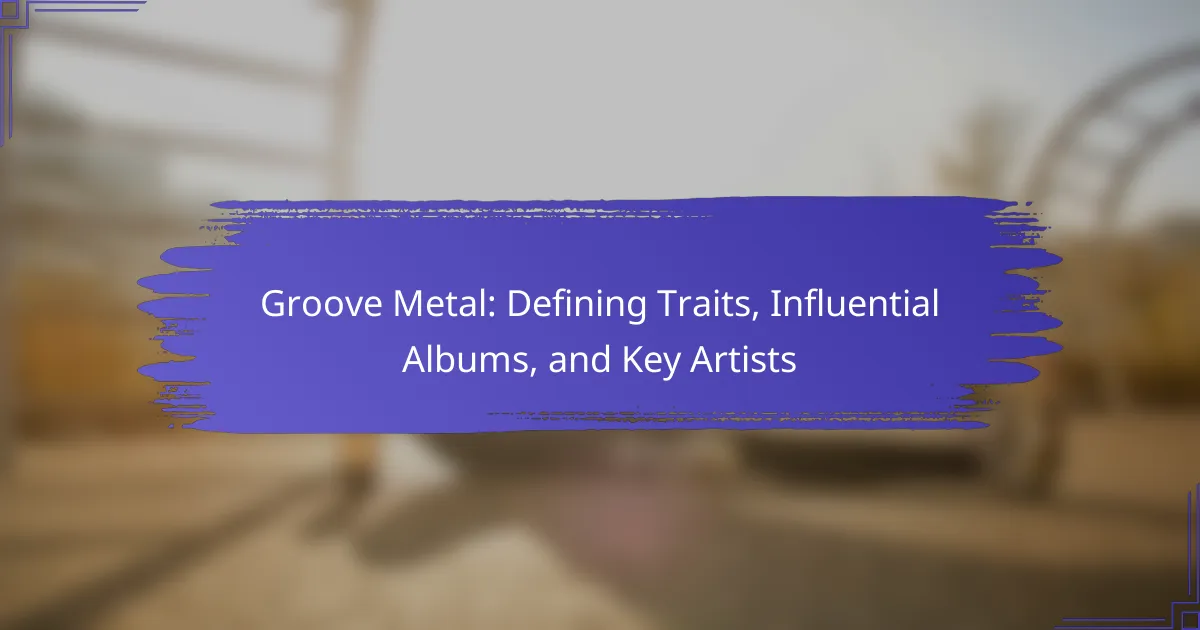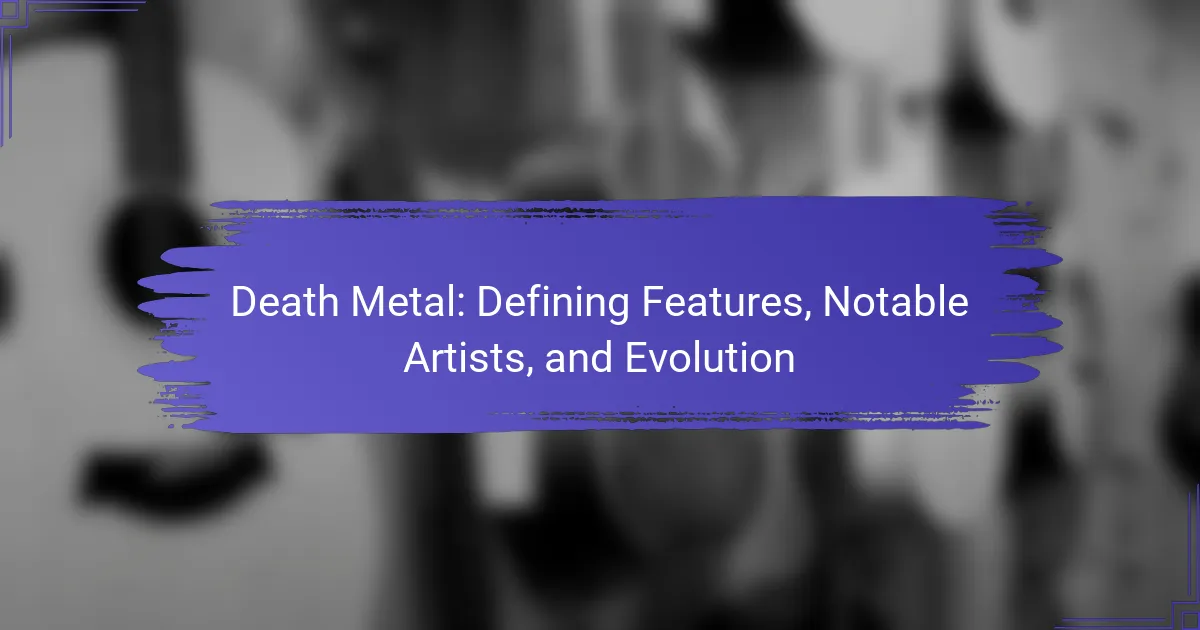Symphonic metal combines heavy metal with orchestral elements, creating a unique sound that captivates listeners. This genre features notable acts like Nightwish and Epica, showcasing intricate arrangements and operatic vocals. Key themes often explore fantasy and personal struggle, while regional variations add to its diversity. The evolution of symphonic metal includes theatrical performances and rare collaborations, enriching the overall musical experience.

How does symphonic metal integrate classical elements into its sound?
Symphonic metal integrates classical elements through orchestral arrangements, operatic vocals, and complex song structures. This genre combines heavy metal instrumentation with symphonic components, creating a rich, layered sound. Notable acts like Nightwish and Epica exemplify this fusion by incorporating string sections, choirs, and classical motifs into their music. The genre’s development has seen an increasing trend towards theatrical performances, enhancing the overall experience and appeal.
What orchestral instruments are commonly used in symphonic metal?
Symphonic metal commonly features orchestral instruments such as strings, brass, woodwinds, and percussion. These instruments enhance the genre’s dramatic and cinematic qualities. Strings, including violins and cellos, provide melodic depth. Brass instruments, like trumpets and trombones, add power and richness. Woodwinds, such as flutes and clarinets, contribute unique tonal colors. Percussion instruments, including timpani and cymbals, create dynamic rhythms. The integration of these orchestral elements differentiates symphonic metal from traditional metal genres.
How do arrangements differ from traditional metal genres?
Symphonic metal differs from traditional metal genres by incorporating orchestral elements and diverse musical influences. This fusion creates a richer sound, blending metal with classical music, choirs, and various instruments. Notable acts like Nightwish and Epica exemplify this genre’s evolution, showcasing complex arrangements and thematic depth. Unlike traditional metal, which often focuses on guitar-driven sound, symphonic metal emphasizes melody and atmosphere, appealing to a broader audience.
What role do choirs play in symphonic metal compositions?
Choirs enhance symphonic metal compositions by adding depth and richness to the music. They create an epic atmosphere, blending orchestral elements with heavy instrumentation. This fusion elevates the emotional impact of the songs, making them more immersive. Notable acts like Nightwish and Epica utilize choirs to achieve a grand sound, often incorporating operatic vocals. This unique attribute distinguishes symphonic metal from other genres, showcasing its dramatic and theatrical qualities.
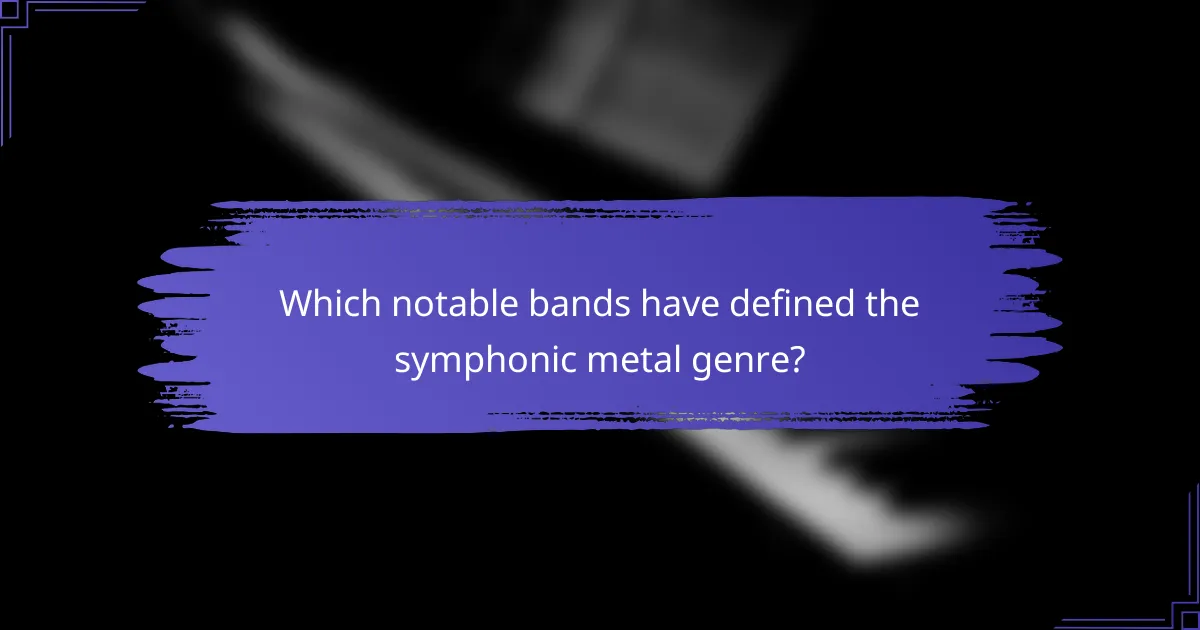
Which notable bands have defined the symphonic metal genre?
Notable bands that have defined the symphonic metal genre include Nightwish, Epica, and Within Temptation. Nightwish pioneered the genre with their blend of operatic vocals and orchestral arrangements. Epica is known for their incorporation of progressive elements and philosophical themes. Within Temptation combines gothic and symphonic influences, creating a unique sound. Other significant acts include Kamelot and Therion, both contributing to the genre’s evolution with their distinct styles and musical complexity.
How did Nightwish influence the evolution of symphonic metal?
Nightwish significantly shaped symphonic metal by integrating orchestral elements with heavy metal. Their innovative sound combined operatic vocals, symphonic arrangements, and metal instrumentation, setting a benchmark for the genre. This fusion encouraged bands like Epica and Within Temptation to explore similar styles, enhancing the genre’s complexity. Nightwish’s albums, such as “Once,” showcased elaborate compositions and storytelling, influencing both musical direction and thematic depth in symphonic metal. Their evolution of sound continues to inspire new acts, solidifying their legacy in the genre.
What contributions has Epica made to the genre’s development?
Epica has significantly influenced symphonic metal by integrating orchestral elements and complex compositions. Their use of diverse vocal styles, including operatic and growled vocals, has expanded the genre’s appeal. They blend classical music with heavy metal, creating a unique sound that highlights both melody and intensity. Epica’s thematic focus on philosophical and social issues has also enriched lyrical depth within the genre. Their innovative approach has inspired numerous bands, fostering the evolution of symphonic metal as a distinct musical style.
Which emerging acts are currently shaping the future of symphonic metal?
Emerging acts currently shaping the future of symphonic metal include bands like Nightwish, Epica, and Within Temptation. These groups blend orchestral elements with metal, evolving the genre’s sound and appeal. Newer acts such as Beast in Black and Delain are also gaining recognition, introducing fresh influences and innovative compositions. Their unique attributes contribute to the genre’s growth and diversification, attracting a broader audience. As a result, symphonic metal continues to evolve, reflecting contemporary themes and musical experimentation.
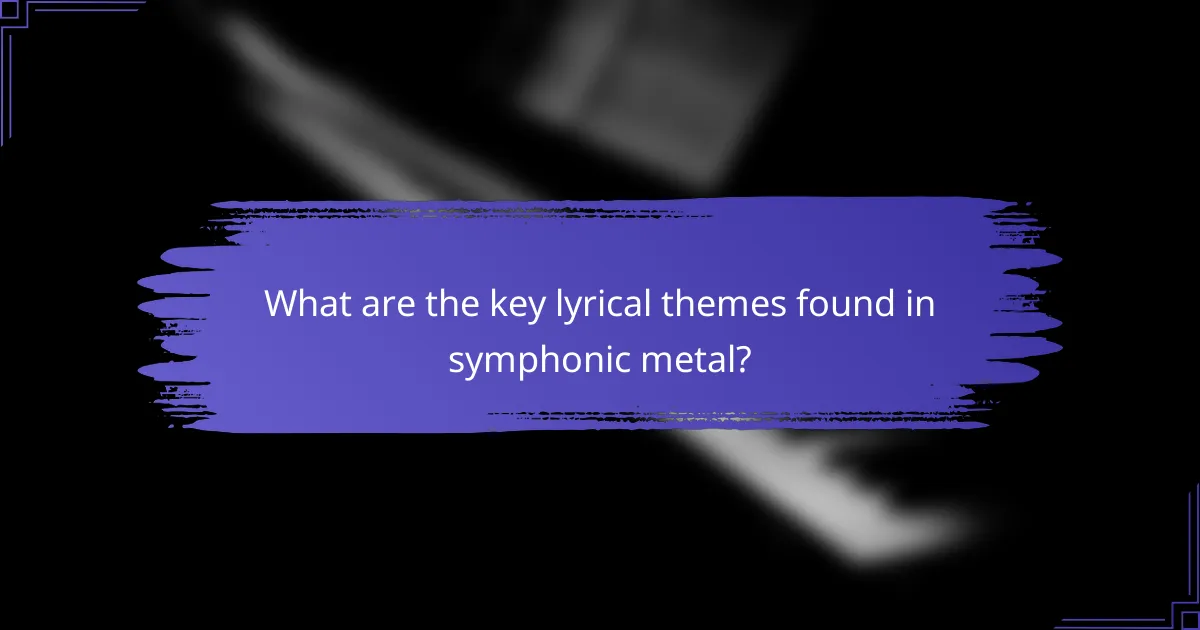
What are the key lyrical themes found in symphonic metal?
Key lyrical themes in symphonic metal include fantasy, mythology, and personal struggle. These themes often explore epic narratives and emotional depth. For example, many songs draw inspiration from literature and historical events, creating a rich tapestry of storytelling. Additionally, existential themes such as identity and mortality frequently appear, offering listeners a profound connection to the music. The fusion of orchestral elements enhances these themes, creating an immersive experience.
How do fantasy and mythology influence the storytelling in this genre?
Fantasy and mythology significantly enrich storytelling in symphonic metal by providing thematic depth and imaginative narratives. This genre often integrates mythical elements, drawing from various cultural legends to create a grandiose atmosphere. Notable acts like Nightwish and Epica exemplify this fusion, using lyrical content inspired by mythological tales.
The incorporation of these themes allows for unique storytelling methods, blending orchestral arrangements with heavy metal instrumentation. This combination enhances emotional resonance, as narratives often explore universal themes of heroism, conflict, and transformation. As a result, symphonic metal not only entertains but also invites listeners to engage with complex, fantastical worlds.
What social and political themes are explored in symphonic metal lyrics?
Symphonic metal lyrics explore themes of social justice, political struggle, and emotional conflict. These themes often reflect societal issues and personal experiences. For instance, bands like Nightwish and Epica address topics such as war, environmentalism, and human rights. The fusion of orchestral elements enhances the emotional depth of these themes, creating a powerful narrative. Additionally, unique attributes of symphonic metal include the incorporation of mythology and fantasy, which serve as metaphors for real-world issues.
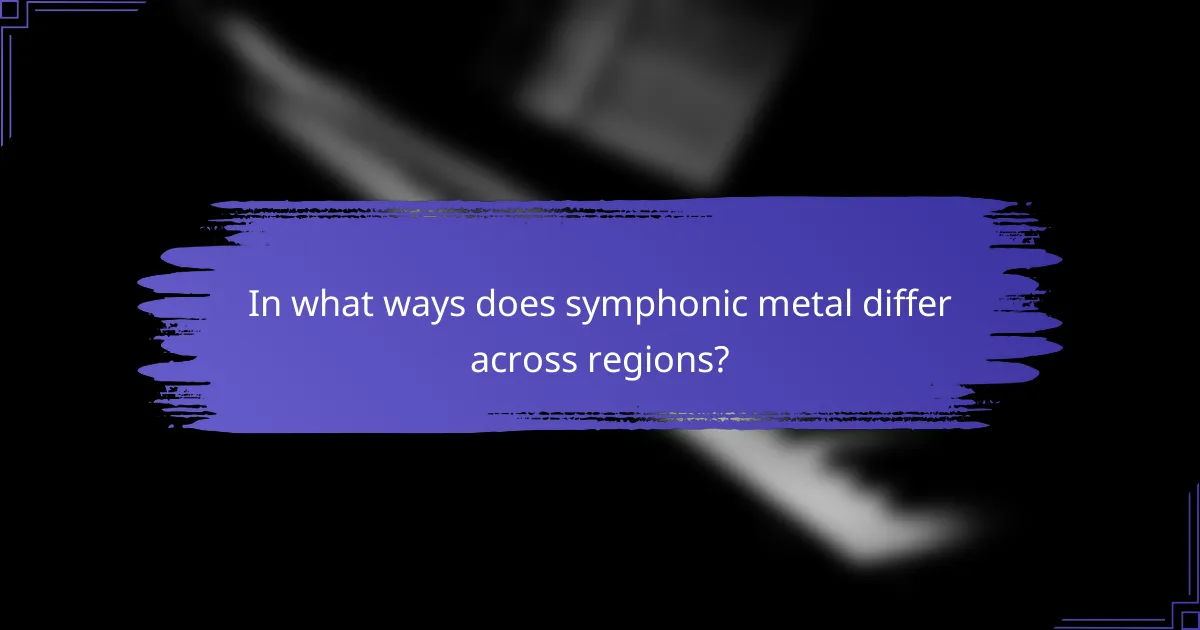
In what ways does symphonic metal differ across regions?
Symphonic metal varies across regions through distinct cultural influences and musical characteristics. In Europe, orchestral arrangements and operatic vocals dominate, while North American bands often incorporate heavier elements and progressive structures. In Japan, symphonic metal blends with anime themes, showcasing unique lyrical content and visual aesthetics. Additionally, regional acts like Nightwish from Finland and Epica from the Netherlands emphasize different instrumental fusions, reflecting local musical traditions. These differences contribute to the genre’s rich diversity and ongoing evolution.
How does the North American interpretation of symphonic metal vary from European styles?
The North American interpretation of symphonic metal often emphasizes a heavier, more aggressive sound compared to European styles. North American bands frequently incorporate elements from other genres like metalcore and progressive metal, creating a distinct fusion. In contrast, European symphonic metal tends to focus more on orchestral arrangements and melodic elements. Notable North American acts, such as Kamelot and Nightwish, showcase these differences through their unique compositions. This divergence illustrates how cultural influences shape the evolution of symphonic metal across regions.
What cultural influences shape the sound of symphonic metal in different countries?
Cultural influences significantly shape the sound of symphonic metal across different countries. In Europe, orchestral elements blend with folk traditions, while in North America, cinematic scores and heavy metal dominate. For instance, Finland’s symphonic metal often incorporates Finnish folklore, creating a unique atmospheric sound. In contrast, the Netherlands emphasizes operatic vocals and complex arrangements, evident in the works of Nightwish and Epica. Each country’s distinct musical heritage adds layers to the genre, enriching its global appeal.
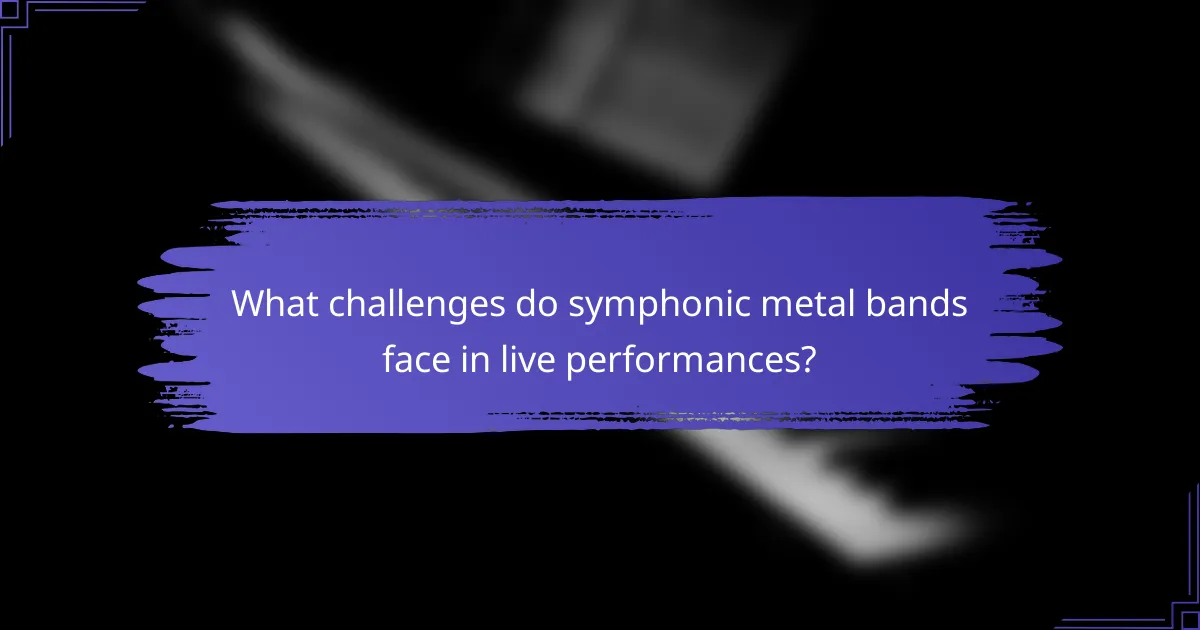
What challenges do symphonic metal bands face in live performances?
Symphonic metal bands face unique challenges in live performances due to their complex arrangements and instrumentation. Coordinating multiple musicians and orchestral elements can lead to timing issues. Additionally, balancing the sound of live instruments with backing tracks or symphonic elements often proves difficult. Venue acoustics can further complicate sound quality, impacting audience experience. Limited stage space may restrict visual elements, hindering the overall performance impact.
How do logistical issues impact orchestral collaborations in concerts?
Logistical issues can significantly disrupt orchestral collaborations in concerts by affecting scheduling, resource allocation, and communication. These challenges can lead to performance delays and misunderstandings among musicians. For instance, coordination of rehearsal times becomes complex when multiple bands are involved, impacting the overall concert flow. Additionally, inadequate transportation arrangements may hinder the timely arrival of instruments and personnel. As a result, effective logistical planning is crucial for successful orchestral collaborations in symphonic metal concerts.
What are the common technical difficulties encountered during live shows?
Common technical difficulties during live shows include sound issues, equipment malfunctions, and synchronization problems. Sound issues often arise from poor mixing or feedback, affecting the overall performance quality. Equipment malfunctions can involve instruments or amplifiers failing, disrupting the flow of the show. Synchronization problems may occur when visual elements do not align with the music, impacting the audience’s experience. Addressing these challenges is crucial for maintaining a high standard in symphonic metal performances.
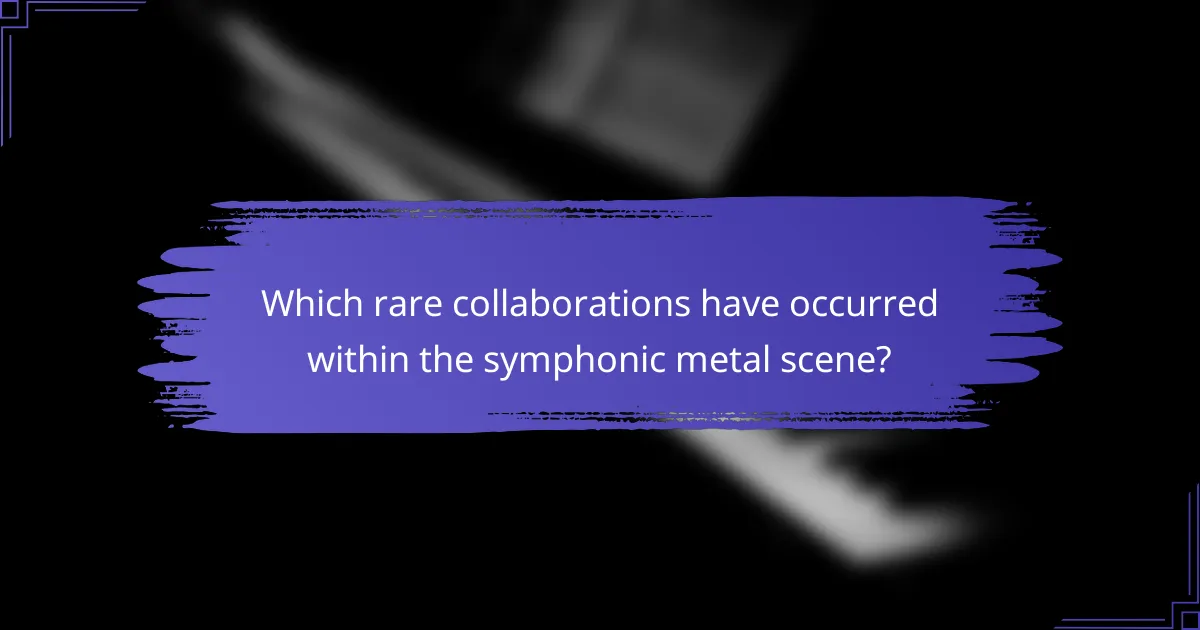
Which rare collaborations have occurred within the symphonic metal scene?
Rare collaborations in the symphonic metal scene include unique pairings that blend diverse musical styles. Notable examples include Nightwish’s collaboration with the London Symphony Orchestra, which showcased orchestral arrangements in their performances. Another significant instance is the partnership between Epica and the Metropole Orchestra, resulting in a powerful live album that fused symphonic elements with metal. Additionally, Within Temptation’s collaboration with the Dutch orchestra is a rare event that highlights the genre’s versatility. These collaborations often push the boundaries of symphonic metal, enriching the genre’s development.
What unique projects showcase cross-genre experimentation in symphonic metal?
Unique projects that showcase cross-genre experimentation in symphonic metal include “The Divine Conspiracy” by Epica, “The Phantom Agony” by Epica, and “Nightfall in Middle-Earth” by Blind Guardian. These albums blend orchestral arrangements with elements from genres like opera, folk, and progressive rock. For instance, Epica’s use of classical choirs and orchestras creates a rich, layered sound that transcends typical metal boundaries. Additionally, the incorporation of narrative storytelling in Blind Guardian’s work highlights the genre’s versatility and artistic depth.
How have symphonic metal bands collaborated with classical musicians?
Symphonic metal bands have collaborated with classical musicians to create unique soundscapes that blend heavy metal with orchestral elements. Notable collaborations include Nightwish’s work with orchestras and Epica’s performances featuring classical musicians. These partnerships enhance the genre’s complexity and showcase its versatility. The fusion often results in rich arrangements that highlight both the power of metal and the elegance of classical music.
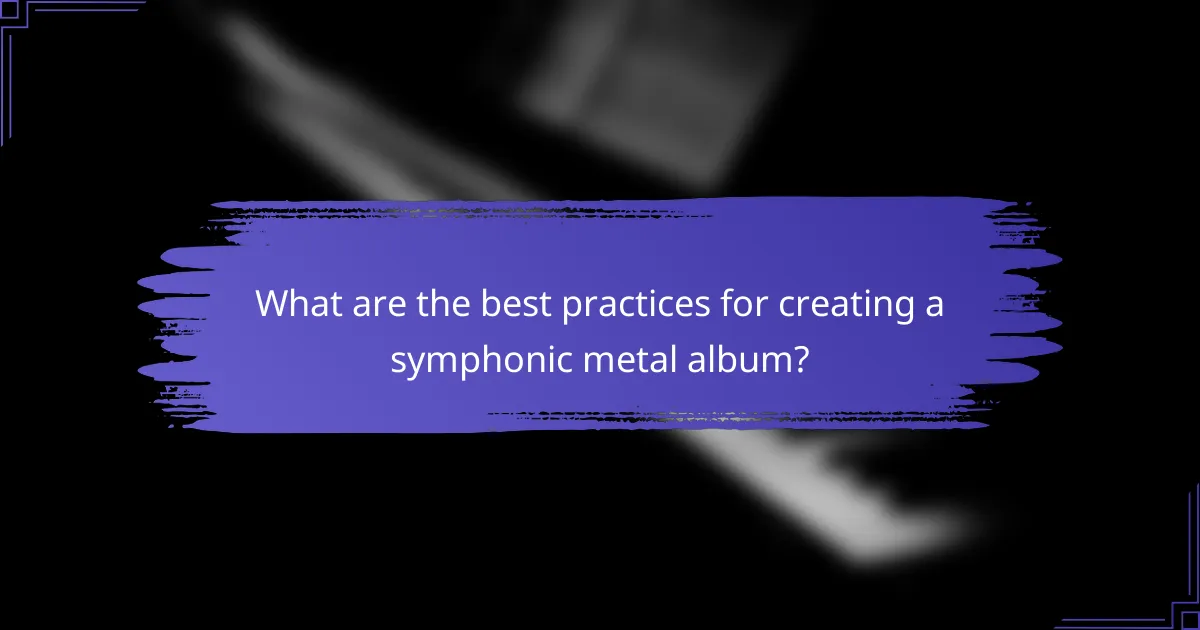
What are the best practices for creating a symphonic metal album?
To create a symphonic metal album, focus on blending orchestral elements with heavy metal. Start with well-defined themes that resonate emotionally. Incorporate diverse instrumentation, including strings and choirs, to enhance depth. Collaborate with skilled musicians to ensure high-quality arrangements. Prioritize production quality to achieve a polished sound. Experiment with dynamics to create contrast between heavy riffs and melodic passages.
How can artists effectively blend orchestration and metal elements?
Artists can effectively blend orchestration and metal elements by integrating symphonic arrangements with heavy guitar riffs. This fusion enhances emotional depth and complexity in the music. Notable acts like Nightwish and Epica exemplify this approach, combining orchestras with powerful vocals and intricate instrumentation. The genre has evolved to include diverse influences, allowing for innovative compositions that appeal to a broad audience.
What production techniques enhance the symphonic sound in recordings?
Production techniques that enhance the symphonic sound in recordings include orchestration, layering, and mixing. Orchestration involves using a full range of instruments to create rich textures. Layering adds depth by superimposing multiple tracks, creating a fuller sound. Mixing balances these elements, ensuring clarity and cohesion. Unique attributes like the use of digital effects can further enhance the symphonic quality, providing a modern twist to traditional sounds.
Which common mistakes should be avoided when composing symphonic metal?
To compose symphonic metal effectively, avoid common mistakes that can hinder creativity and coherence. First, neglecting the integration of orchestral elements can lead to a lack of depth. Additionally, overcomplicating arrangements may confuse listeners. Failing to maintain a balance between heavy instrumentation and melodic lines can weaken the overall impact. Lastly, disregarding lyrical themes that resonate with the genre’s dramatic nature can result in a disconnect with the audience.


